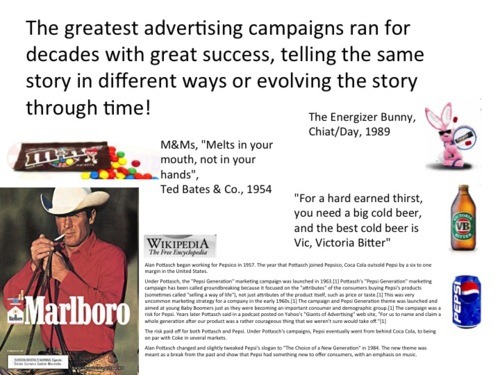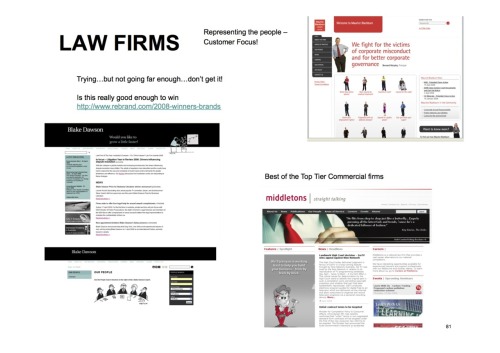
Famous Advertising Campaign Themes and Characters dealing with Brand Positioning



To develop an effective creative theme, your brand positioning needs to be different from what is prevalent in your industry segment. One way of doing this is staying away from standard photography stock photos. Not only will this not provide your business with the necessary point of difference but will play into the hands of the category leader, who is most likely already using the “typical” stock shots.
Here are some examples of effectively used creative themes:
A Gambling theme was used for a management consulting member organisation to communicate with both prospective members and encourage membership and potential clients, with the main messages being:
A Cartoon theme for an accounting practice and a different cartoon theme for a management consulting firm both poking fun at their own practice were used to differentiate these companies from their competition that uses traditional and boring “corporate” photos of “smiling people in the office”
A visual Illusion theme for a marketing consultancy was used to deliver the message that things aren’t always what they seem and that Perception is Reality!
A theme of the world’s most famous Man-Made Landmarks was developed for a translation company to differentiate them and make their offer more memorable than their competitors.
A Car theme was designed for a web marketing company that was at the time an early developer of an easy to use web Content Management System:
A Medical theme was developed for an I.T. company. Most I.T. companies can’t get beyond the now “typical” I.T. Health Check. This I.T. company was able to develop a campaignable and timeless theme which was intrinsically linked to its Positioning Statement / slogan which was “taking care of I.T.”
Wild West theme was used by a design firm, with all the shoot outs, outlaws, sheriff and wanted posters to create a fun approach to selling this firm’s point of difference.
As you can see the creative theme for your business is only limited by your imagination. From police or detectives, to aliens and UFO’s, from tailoring to sailing, from army to mythology, the critical things to remember are:


Why is it that some of our society’s brightest minds have no idea how to translate their “no holds barred” skills from the courtroom to the public domain of marketing communication in a battle to win more clients?
Maybe they just don’t need the extra business, maybe they don’t know how, or maybe the truth is a combination of arrogance and ignorance steeped in tradition! If you want to know the historical reasons why the legal profession is the way it is when it comes to brand positioning in marketing and advertising, then you’ll see an excellent exposé here:
http://www.law.com/jsp/llf/PubArticleLLF.jsp?id=1181207138051 by the (American) National Law Journal.
I am sure that you can put your hand on your heart and say that your new product or service is different and unique.
You have a point of difference that would convert a prospective customer in seconds. But how?
Here’s a checklist to ensure that you convert your prospective customers with the proper positioning strategy:
1. Look reputable:
2. Build confidence:
3. Get noticed:
To find out how we help our clients to play with the big boys, contact us now. We are a marketing agency and advertising agency, all in one and our website is full of information on brand identity and styling, content development and campaign development. By working on looking reputable, building confidence and getting noticed through the right positioning strategy, you’ll look just like a big player in your market, on a small budget. Remember ‘Perception is Reality’! We’ll help you to launch your brand successfully and maximise the return on your marketing investment.
I say you should. In fact you should make every effort to do so! In general, the better your idea or Intellectual Property (IP), the harder it is to sell it, to get people to believe in it.
Your so called IP is already ‘on Google’ and if you think your IP will somehow protect your business, you’re sadly mistaken. Today anyone can learn how to do anything simply by going onto Google, YouTube, or in any of the social media channels.
But just because your prospects know what to do they will not necessarily know the intricacies of how to do it. As a marketing company, qubePartners has made many marketing resources freely available for all to see and download – http://www.qubepartners.com/marketing-resources. These templates have taken us many years to develop and we believe they are the best free small business marketing and advertising resources available. We were at first hesitant just giving them away. But then we realised that it is not only the questions in these marketing templates that deliver the results but what you do with the answers that makes all the difference. Here is a blog on ‘Marketing Secrets’ that discusses this in detail: http://www.qubepartners.com/blog/beware-of-marketing-secrets-the-problem-with-sme-marketing
Furthermore your customers may not have the patience or the skill to do so which is where you expertise comes in. By giving away your so-called IP you can exhibit thought leadership and you can provide your future customers with the confidence of knowing that you can help them, which will put your business in their “top of mind” for when the time comes to choose a provider of what ever it is you specialise in!
Here are a few examples of freely available IP and how this has not changed the market dynamics:
Why?
You can now see the list of I.P. being given away or do-it-yourself advice is never ending…there is information on every topic imaginable and it is free! From SEO to Photography, Conveyancing and Plumbing you can get it all at a click of your mouse. Why does a UK Plumbing company have hundreds of Plumbing Video’s online for free? Because it understands that by doing so they will be seen as an expert which will help them win much better and more complex jobs, and they also understand that there will always be a segment of the market who will watch their YouTube video and say “it looks too hard, I’ll just call them!”
According to a study by research company Millward Brown, slogan or brand positioning statement usage in advertising has been declining over the last 20 years.
The study found that slogans make a difference in advertisements, and generate more interest from the target audience. The Knowledge Point study, found that two-thirds of all ads actually included slogans.
Ads with slogans that part are of a jingle received higher enjoyment while slogans that have been used before also enjoyed better branding, confirming the importance of consistency and repetition.
The study provided the following advice to marketers and their brands:
Recent Comments